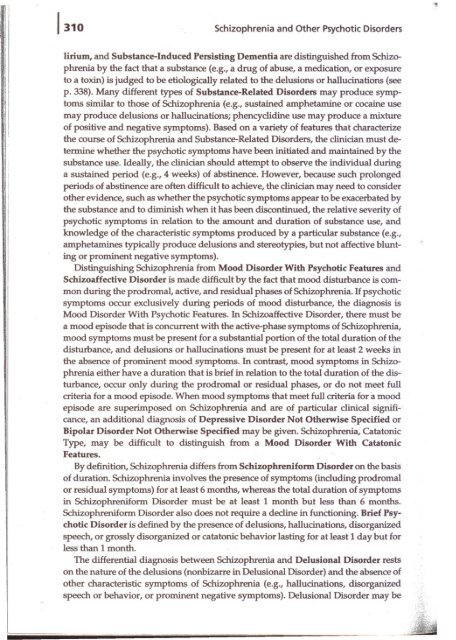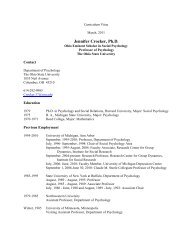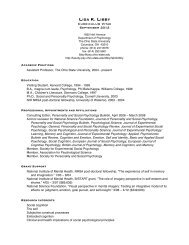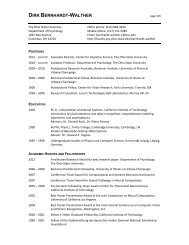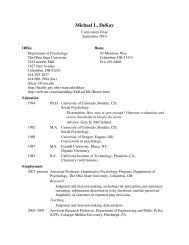Schizophrenia and Other Psychotic Disorders pg297-315.pdf
Schizophrenia and Other Psychotic Disorders pg297-315.pdf
Schizophrenia and Other Psychotic Disorders pg297-315.pdf
Create successful ePaper yourself
Turn your PDF publications into a flip-book with our unique Google optimized e-Paper software.
" I ,I<br />
Iii<br />
I' I<br />
11<br />
I<br />
I<br />
I<br />
<strong>Schizophrenia</strong> <strong>and</strong> <strong>Other</strong> <strong>Psychotic</strong> <strong>Disorders</strong><br />
lirium, <strong>and</strong> Substance-Induced Persisting Dementia are distinguished from <strong>Schizophrenia</strong><br />
by the fact that a substance (e.g., a drug of abuse, a medication, or exposure<br />
to a toxin) is judged to be etiologically related to the delusions or hallucinations (see<br />
p. 338). Many different types of Substance-Related <strong>Disorders</strong> may produce symptoms<br />
similar to those of <strong>Schizophrenia</strong> (e.g., sustained amphetamine or cocaine use<br />
may produce delusions or hallucinations; phencyclidine use may produce a mixture<br />
of positive <strong>and</strong> negative symptoms). Based on a variety of features that characterize<br />
the course of <strong>Schizophrenia</strong> <strong>and</strong> Substance-Related <strong>Disorders</strong>, the clinician must determine<br />
whether the psychotic symptoms have been initiated <strong>and</strong> maintained by the<br />
substance use. Ideally, the clinician should attempt to observe the individual during<br />
a sustained period (e.g., 4 weeks) of abstinence. However, because such prolonged<br />
periods of abstinence are often difficult to achieve, the clinician may need to consider<br />
other evidence, such as whether the psychotic symptoms appear to be exacerbated by<br />
the substance <strong>and</strong> to diminish when it has been discontinued, the relative severity of<br />
psychotic symptoms in relation to the amount <strong>and</strong> duration of substance use, <strong>and</strong><br />
knowledge of the characteristic symptoms produced by a particular substance (e.g.,<br />
amphetamines typically produce delusions <strong>and</strong> stereotypies, but not affective blunting<br />
or prominent negative symptoms).<br />
Distinguishing <strong>Schizophrenia</strong> from Mood Disorder With <strong>Psychotic</strong> Features <strong>and</strong><br />
Schizo affective Disorder is made difficult by the fact that moOd disturbance is common<br />
during the prodromal, active, <strong>and</strong> residual phases of <strong>Schizophrenia</strong>. U psychotic<br />
symptoms occur exclusively during periods of mood disturbance, the diagnosis is<br />
Mood Disorder With <strong>Psychotic</strong> Features. In Schizoaffective Disorder, there must be<br />
a mood episode that is concurrent with the active-phase symptoms of <strong>Schizophrenia</strong>,<br />
mood symptoms must be present for a substantial portion of the total duration of the<br />
disturbance, <strong>and</strong> delusions or hallucinations must be present for at least 2 weeks in<br />
the absence of prominent mood symptoms. In contrast, mood symptoms in <strong>Schizophrenia</strong><br />
either have a duration that is brief in relation to the total duration of the disturbance,<br />
occur only during the prodromal or residual phases, or do not meet full<br />
criteria for a mood episode. When mood symptoms that meet full criteria for a mood<br />
episode are superimposed on <strong>Schizophrenia</strong> <strong>and</strong> are of particular clinical significance,<br />
an additional diagnosis of Depressive Disorder Not <strong>Other</strong>wise Specified or<br />
Bipolar Disorder Not <strong>Other</strong>wise Specified may be given. <strong>Schizophrenia</strong>, Catatonic<br />
Type, may be difficult to distinguish from a Mood Disorder With Catatonic<br />
Features .<br />
.By definition, <strong>Schizophrenia</strong> differs from Schizophreniform Disorder on the basis<br />
of duration. <strong>Schizophrenia</strong> involves the presence of symptoms (including prodromal<br />
or residual symptoms) for at least 6 months, whereas the total duration of symptoms<br />
in Schizophreniform Disorder must be at least 1 month but less than 6 months.<br />
Schizophreniform Disorder also does not require a decline in functioning. Brief <strong>Psychotic</strong><br />
Disorder is defined by the presence of delusions, hallucinations, disorganized<br />
speech, or grossly disorganized or catatonic behavior lasting for at least 1 day but for<br />
leSs than 1 month.<br />
The differential diagnosis between <strong>Schizophrenia</strong> <strong>and</strong> Delusional Disorder rests<br />
on the nature of the delusions (nonbizarre in Delusional Disorder) <strong>and</strong> the absence of<br />
other characteristic symptoms of <strong>Schizophrenia</strong> (e.g., hallucinations, disorganized<br />
speech or behavior, or prominent negative symptoms). Delusional Disorder may be


